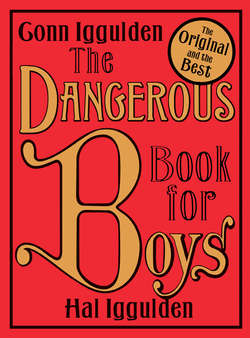Читать книгу The Dangerous Book for Boys - Conn Iggulden - Страница 13
Making a Battery
ОглавлениеA BATTERY AT ITS SIMPLEST is a cathode (the positive end), an anode (the negative end) and electrolyte (the bit in the middle). There are quite a few different combinations out there. Electricity is the movement of electrons, tiny negatively charged particles. The anode tends to be made of a substance that gives up electrons easily – like zinc, which gives up two electrons per zinc atom. The cathode tends to be made of substances that accept electrons easily, like copper.
The electrolyte inside can be a liquid, a gel or a paste. All that matters is that it contains positive and negatively charged ions that flow when the anode and cathode are activated. When the Italian physicist Alessandro Volta made the first battery, he used copper for the cathode, zinc for the anode and an electrolyte of blotting paper and sea water. His name gives us the word ‘volt’, as in a 12-volt car battery. If you think of electricity as a water pipe, a volt will be the speed of the water, but it also needs a big hole to flow through – or ‘amps’. You can have enough voltage to make your hair stand on end, but without amps, it won’t do more than cause a tiny spark. A house supply, however, has 240 volts and enough amps to kill you as dead as a doornail.
You will need
Ten two-pence pieces.
Metal kitchen foil.
Blotting paper.
Two pieces of copper wire (taken from any electrical wire or flex).
Malt vinegar.
Salt.
Bowl.
LED – a light emitting diode (available from model and hardware shops).
Masking tape.
The copper coin will be the cathode, the foil the anode.
Cut the foil and blotting paper into circles so they can be stacked on top of each other. The blotting paper will be soaked in the vinegar, but it is also there to prevent the metals touching – so cut those paper circles a little larger than the foil or coins.
1. Mix vinegar and a little salt together in the bowl. Vinegar is acetic acid and all acids can be used as an electrolyte. Sulphuric acid is found in car batteries, but don’t fool around with something that powerful. It eats clothing and can burn skin – unlike vinegar, which goes on your chips.
Common salt is sodium chloride, a combination of a positive and negative ion (Na+ and Cl–). These will separate in the electrolyte, increasing its strength.
2. Soak your circles of blotting paper in the ion-rich electrolyte.
3. With the masking tape, attach the end of one wire to the underneath of a foil disc. This is the negative terminal. Now stack in this sequence – foil, paper, coin, foil, paper, coin. Each combination is its own tiny battery – but to light even an LED (light-emitting diode) you’ll need quite a few. A car battery tends to have six of these, but with a much larger surface area for each ‘cell’. As a general rule, the bigger a battery is, the more power it has. (Power measured in Watts = amps × volts.)
All the positive ions will go to one terminal, all the negative ions to the other. In effect, you are charging your battery.
4. When you have a stack, you can attach a wire to the last coin with tape. This will be the positive terminal. They can now light an LED, as in the picture below, or with enough coin batteries, even a small bulb.
There may come a time when batteries go on to a new generation, but if you can understand the battery you have just made, you can understand every type of battery currently available, from nickel-cadmium, to lithium-ion, from rechargeable phone batteries, to the ones that drive toy rabbits. You won’t hear acid sloshing in alkaline batteries, where a paste or gel is used, but the principles are identical.
